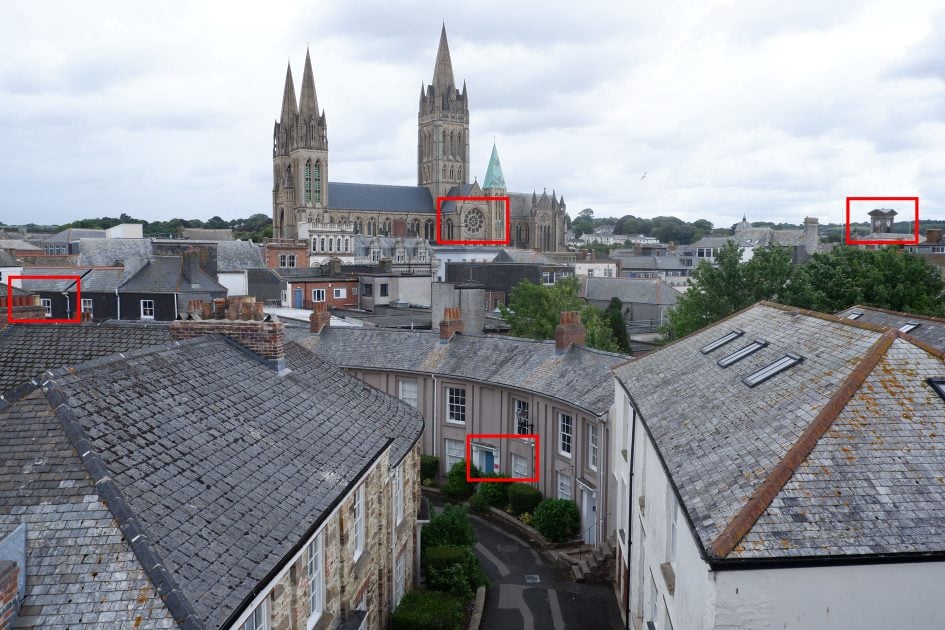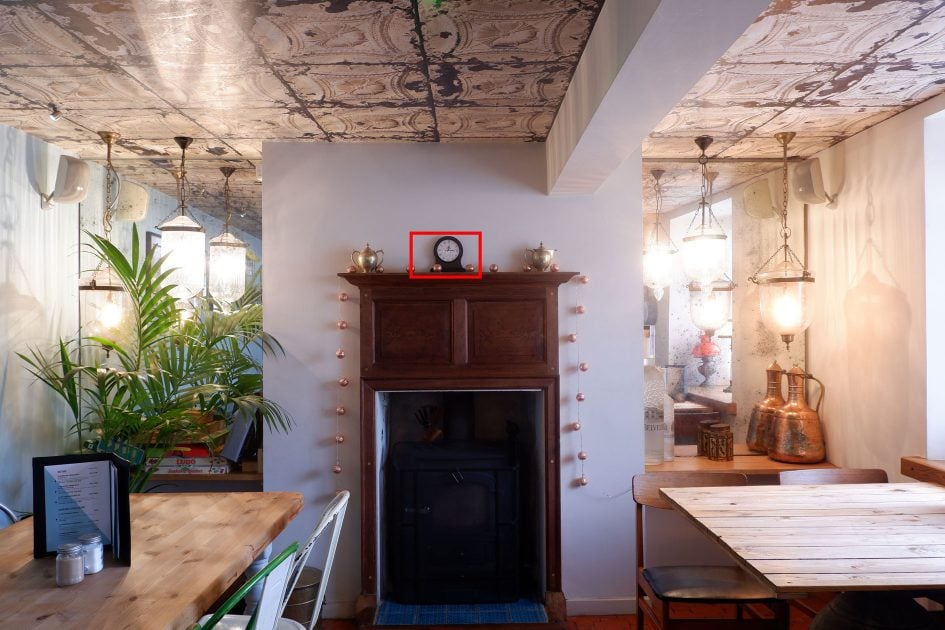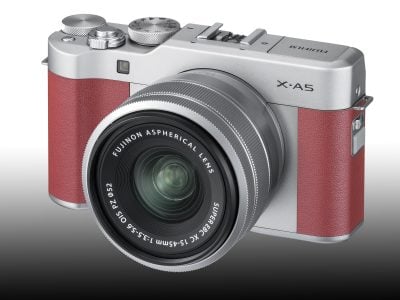Fujifilm XA5 review
-
-
Written by Ken McMahon
Quality
To test real-life performance, I shot this scene with the Fujifilm X-A5 and the Olympus PEN E-PL9 using their best quality JPEG modes. The Fujifilm X-A5 was fitted with the XC 15-45mm f3.5-5.6 OIS PZ lens and the PEN E-PL9 with the 14-42mm f3.5-5.6 EZ. Both cameras were mounted on a tripod and stabilisation was disabled, the sensitivity was manually set to the 200 ISO base sensitivity setting. I set both models to Aperture priority mode and selected f5.6 and they both metered an exposure of 1/500. As usual, the crops are taken from the areas marked in red below.
The Fujifilm X-A5’s 24 Megapixel APS C sensor produces images measuring 6000 x 4000 pixels conpared with 4608 x 3456 pixels for the 16 Megapixel Four Thirds sensor in the PEN E-PL9. Consequently the 100 percent crops from the Fujifilm X-A5 show a smaller area with bigger detail.
The X-A5 shares the same sensor as the X-T100 which employs a traditional Bayer colour filter array as opposed to the X-Trans design reserved for higher-end models. If you take a look at Gordon’s Fujifilm X-T100 review, you’ll see that the style and the overall quality of the images is actually very similar – which is to say excellent. Despite it being a slightly overcast day, these crops are sharp, punchy and packed with detail.
The new 15-45mm f3.5-5.6 OIS powered zoom produces a little bit of distortion at the frame edges at the 15mm wide angle position and you can also spot a little bit of chromatic aberration, as evidenced by the colour fringing.
Aside from that, there’s masses of detail in these crops and if you compare the second crop from the middle of the frame with the one from the Olympus PEN E-PL9 I think you’d have to agree that the X-A5 detail is not only bigger, there’s more of it and it’s sharper. The Olympus lens does a better job at the frame edge than the Fujinon though.
Fujifilm X-A5 vs Olympus PEN E-PL9 (100% crops)
Above left: Fujifilm X-A5 at f5.6. Above right: Olympus PEN E-PL9 at f5.6
Above left: Fujifilm X-A5 at f5.6. Above right: Olympus PEN E-PL9 at f5.6
Above left: Fujifilm X-A5 at f5.6. Above right: Olympus PEN E-PL9 at f5.6
Above left: Fujifilm X-A5 at f5.6. Above right: Olympus PEN E-PL9 at f5.6
Fujifilm X-A5 Noise
To evaluate the low-light performance of their sensors, I photographed this still-life scene with the Fujifilm X-A5 and the Olympus PEN E-PL9 fitted with their respective kit lenses and set to their best quality JPEG image settings. Both cameras were mounted on a tripod and stabilisation was disabled. I set them both to Aperture priority exposure mode and selected f5.6. I applied -1/3EV exposure compensation on the X-A5 to give an exposure of 0.5s – compared with 0.4s on PEN E-PL9 . The crops are taken from the area marked in red below.
As you cast your eye down the two rows of crops below, there are a few things to bear in mind. Firstly, as for the quality comparison above, the differing sensor resolution between these models (24 Megapixels on the X-A5 compared with 16 on the PEN E-PL9) means the X-A5 crops show a smaller area with larger detail.
Another thing to consider is that for both of these models the base ISO sensitivity is 200 ISO – the 100 ISO settings is only available if you select the extended ISO range from the X-A5’s menu as are the 25600 and 51200 settings – and these are only available in JPEG shooting modes. And although the ‘Low’ 100 ISO setting on the PEN E-PL9 is always available and can be used for RAW shooting as well as JPEG, it is, effectively an extended setting. For everyday shooting it’s the 200 ISO setting which you should regard as the base. So let’s jump in and take a look at the crops.
Overall the noise performance of the Fujifilm XA-5’s sensor is very impressive. I can’t see visible noise textures in the 200 and 400 ISO crops and even at 800 it’s slight. From there on up, as you’d expect, the noise increases incrementally, but the noise gains are small and regular with the result that the 6400 ISO crop looks very good with lots of detail still visible.
The 12800 ISO setting is perfectly useable for smaller images and with two extended settings up to a maximum of 51200 ISO there’s scope for getting shots, albeit noisy ones, in very low light conditions.
By comparison, I’d say the crops from the Olympus PEN E-PL9 are ever so slightly noisier from around 800 ISO up, though in the lower 100 to 400 ISO range it’s difficult to see much of a difference. The fact that the X-A5 has more detail to begin with makes it difficult to isolate the noise from other factors, but there’s little doubt that from 3200 ISO upwards the Fujifilm X-A5’s sensor outperforms the Olympus PEN E-PL9’s for noise.
Fujifilm X-A5 vs Olympus PEN E-PL9 Jpeg noise
Above left: Fujifilm X-A5 at 100 ISO. Above right: Olympus PEN E-PL9 at 100 ISO
Above left: Fujifilm X-A5 at 200 ISO. Above right: Olympus PEN E-PL9 at 200 ISO
Above left: Fujifilm X-A5 at 400 ISO. Above right: Olympus PEN E-PL9 at 400 ISO
Above left: Fujifilm X-A5 at 800 ISO. Above right: Olympus PEN E-PL9 at 800 ISO
Above left: Fujifilm X-A5 at 1600 ISO. Above right: Olympus PEN E-PL9 at 1600 ISO
Above left: Fujifilm X-A5 at 3200 ISO. Above right: Olympus PEN E-PL9 at 3200 ISO
Above left: Fujifilm X-A5 at 6400 ISO. Above right: Olympus PEN E-PL9 at 6400 ISO
Above left: Fujifilm X-A5 at 12800 ISO. Above right: Olympus PEN E-PL9 at 12800 ISO
Above left: Fujifilm X-A5 at 25600 ISO. Above right: Olympus PEN E-PL9 at 25600 ISO
Above left: Fujifilm X-A5 at 51200 ISO.
Check prices on the Fujifilm X-A5 at Amazon, B&H, Adorama, or Wex. Alternatively get yourself a copy of my In Camera book or treat me to a coffee! Thanks!



















